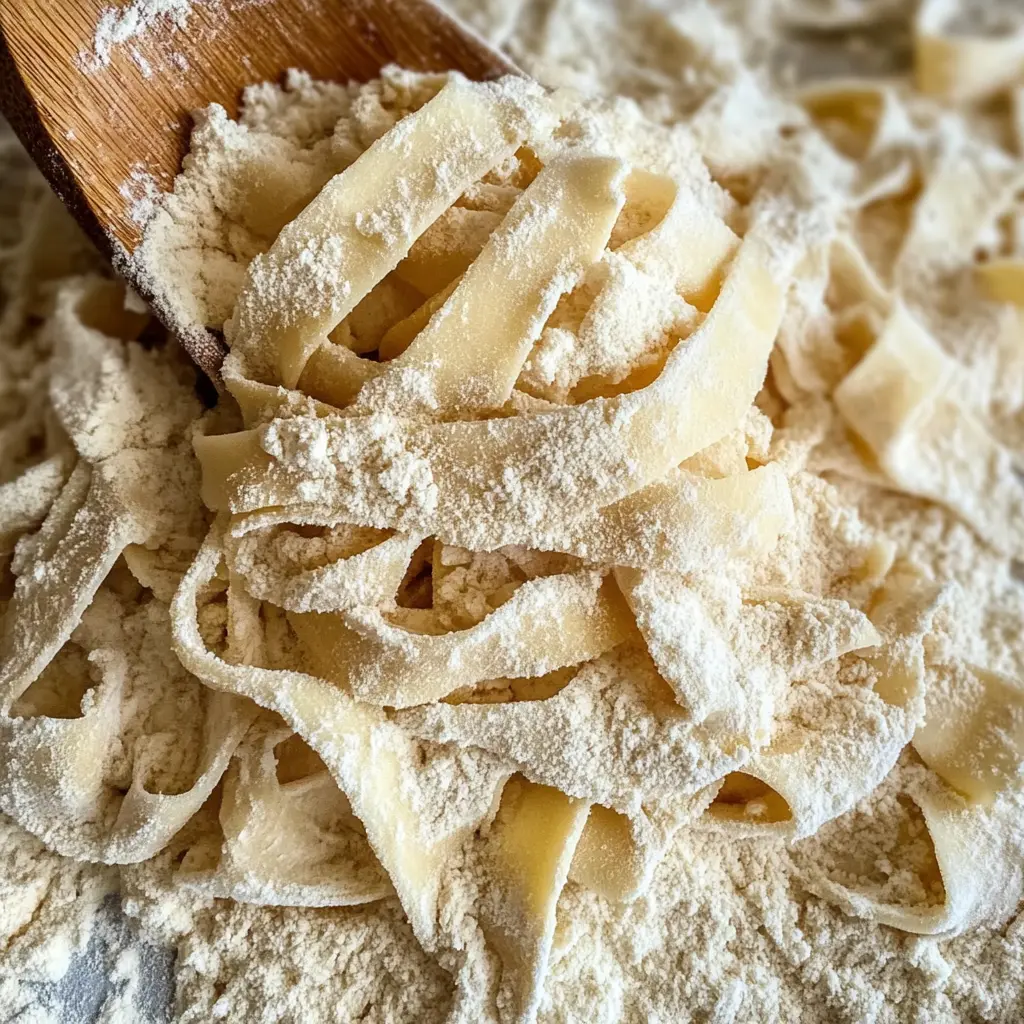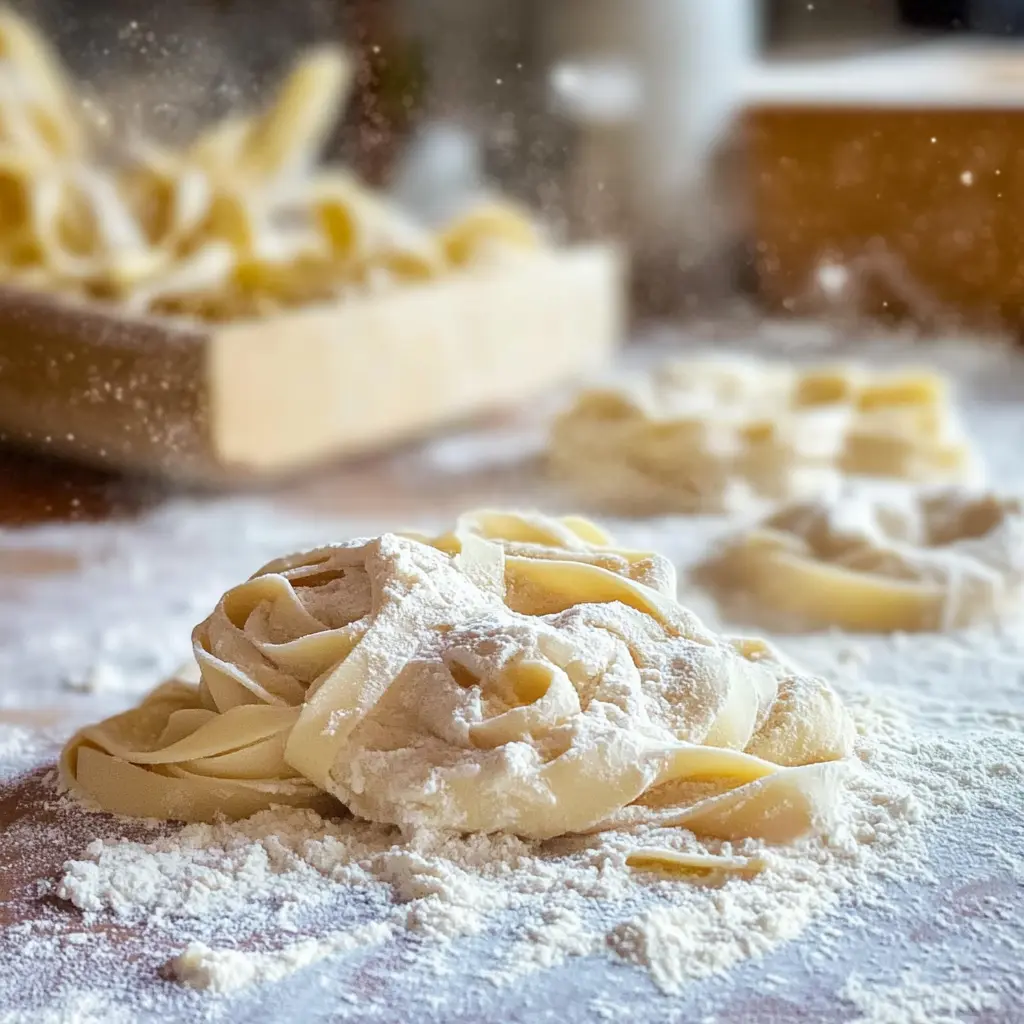– **Title**: Fresh Homemade Sourdough Pasta Dough
– **Ingredients**:
– 2 cups all-purpose flour (plus extra for dusting)
– 1/2 teaspoon salt
– 1 large egg
– 1/2 cup sourdough starter (active and bubbly)
– 1 tablespoon olive oil (optional)
– Water (as needed)
– **Instructions**:
1. In a large mixing bowl, combine the all-purpose flour and salt. Make a well in the center of the flour mixture.
2. Crack the egg into the well, then add the sourdough starter and olive oil if using.
3. Using a fork, slowly incorporate the flour from the edges of the well into the wet ingredients until a dough begins to form.
4. Knead the dough by hand on a floured surface for about 5-10 minutes until it is smooth and elastic. If the dough is too sticky, add a little more flour as needed.
5. Wrap the dough in plastic wrap and let it rest for at least 30 minutes at room temperature. This allows the gluten to relax, making it easier to roll out.
6. After resting, divide the dough into smaller portions (for easier handling). Roll out each portion using a pasta machine or a rolling pin to your desired thickness.
7. Cut the rolled-out dough into your preferred pasta shape (e.g., fettuccine, pappardelle, or lasagna sheets).
8. Dust the cut pasta with a little flour to prevent sticking. Let it dry for a few minutes before cooking.
9. Cook the freshly made pasta in boiling salted water for 2-4 minutes, depending on the thickness. Drain and serve with your favorite sauce.
Enjoy your homemade sourdough pasta!
Key Ingredients & Substitutions
All-purpose Flour: This is your main base for the pasta. You can use whole wheat flour for a nuttier flavor or semolina flour for a firmer texture. Just keep in mind, using different flours might slightly change the water needed.
Sourdough Starter: Make sure your starter is fed and bubbly for the best results. If you don’t have starter, you could use a store-bought pasta recipe or replace it with more flour and an additional egg for a different texture.
Egg: The egg adds richness and helps bind the dough. If you’re looking for an egg-free option, consider using a flaxseed egg (1 tablespoon ground flaxseed combined with 2.5 tablespoons water) or silken tofu, though it changes the flavor slightly.
Salt: This enhances flavor, so don’t skip it! You can also use sea salt or kosher salt, just adjust the quantity since the sizes of the grains differ.
Water: Water is added as needed to achieve the right dough consistency. You can replace it with extra sourdough starter if you want a stronger sourdough flavor—just keep everything balanced.
How Do I Knead My Dough Effectively?
Kneading is essential for developing gluten, making your pasta dough stretchy and elastic. Here’s how to knead it correctly:
- After mixing in the ingredients, transfer your dough onto a floured surface.
- Push the dough away from you with the heel of your hand, fold it over, and then rotate it a quarter turn.
- Repeat this process for about 8-10 minutes until the dough is smooth and elastic. If it’s sticking, dust with a little more flour.
- Remember, if the dough feels too dry, add water one tablespoon at a time until it forms a cohesive ball. You want it just right—soft, not sticky!
Trust me, the effort put into kneading pays off in the texture of your pasta!

How to Make Fresh Homemade Sourdough Pasta Dough
Ingredients You’ll Need:
- 2 cups all-purpose flour, plus extra for dusting
- ½ cup active sourdough starter, fed and bubbly
- 1 large egg
- ½ teaspoon salt
- Water, as needed (1-2 tablespoons)
How Much Time Will You Need?
This recipe takes about 10 minutes of prep time, plus 30 minutes of resting time for the dough. You’ll be mixing, kneading, and resting the dough, which makes it easier to roll out later. After that, cooking the pasta takes about 2-3 minutes. In total, expect to spend about 45 minutes!
Step-by-Step Instructions:
1. Mixing the Dry Ingredients:
In a large mixing bowl, pour in 2 cups of all-purpose flour and add the salt. Make a little well in the center of the flour. This well is where you will add your wet ingredients. It’s important to mix them in gradually!
2. Adding Wet Ingredients:
Into the well, add ½ cup of your bubbly sourdough starter and 1 large egg. Using a fork, start gently mixing the wet ingredients into the flour. Gradually incorporate more of the flour from the sides as you mix until you begin to see a dough forming. It might feel a bit sticky at first, but that’s normal!
3. Kneading the Dough:
Once the dough starts to come together, it’s time to use your hands! Transfer it to a floured surface or keep it in the bowl, and knead it for about 8-10 minutes. You want the dough to be smooth and elastic. If it feels too dry or crumbly, add water one tablespoon at a time until it holds together nicely.
4. Resting the Dough:
After kneading, wrap the dough in plastic wrap or cover it with a damp cloth. Let it rest at room temperature for at least 30 minutes. This helps loosen the gluten, making it easier to roll out later.
5. Rolling Out the Dough:
Once the dough has rested, divide it into four quarters. Take one piece at a time and roll it out using a pasta machine or a rolling pin. Flour your surface as needed to keep the dough from sticking. Roll until you reach your desired thickness for your pasta.
6. Cutting the Pasta:
With your rolled-out dough, cut it into your favorite pasta shape, like fettuccine or tagliatelle. Remember to sprinkle some flour on the cut pieces to prevent them from sticking together.
7. Cooking the Pasta:
Bring a large pot of salted water to a boil. Once boiling, add your fresh pasta and cook for about 2-3 minutes, or until it’s al dente. Be careful not to overcook it! Once done, drain your pasta and it’s ready to serve with your favorite sauce.
Enjoy your delicious homemade sourdough pasta!

Can I Use Whole Wheat Flour Instead of All-Purpose Flour?
Absolutely! You can substitute whole wheat flour for all-purpose flour, but keep in mind that it will result in a denser pasta. You may need to add a bit more water since whole wheat flour absorbs more moisture. Start with the original amount and gradually add water if the dough feels too dry.
How Can I Adjust the Recipe for a Vegan Option?
To make this pasta dough vegan, simply omit the egg and replace it with 2 tablespoons of aquafaba (the liquid from canned chickpeas) or a flax egg (1 tablespoon ground flaxseed mixed with 2.5 tablespoons water). Just remember to add a bit more water, as the dough may need it without the egg!
What Should I Do If My Dough Is Too Sticky?
If your dough is too sticky, don’t worry! Simply sprinkle additional flour onto your work surface and gradually knead in more flour until the dough reaches a smooth, manageable consistency. Avoid adding too much flour at once to keep your pasta tender.
Can I Store Pasta Dough for Later Use?
Yes, you can! Wrap the dough tightly in plastic wrap and store it in the refrigerator for up to 2 days. If you want to keep it longer, freeze it for up to a month. Just make sure to thaw it in the fridge overnight before using it.


